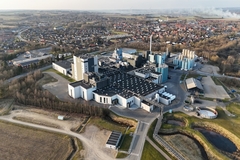
- Industry news
Industry news
- Category news
Category news
- Reports
- Key trends
- Multimedia
Multimedia
- Journal
- Events
- Suppliers
- Home
- Industry news
Industry news
- Category news
Category news
- Reports
- Key trends
- Multimedia
Multimedia
- Events
- Suppliers
Cell-based seafood makes waves: BlueNalu scores US$20m in funding
The cell-based seafood company has received funding from five strategic investors, including Griffith Foods, Nutreco, Pulmuone, Rich Product Ventures and Sumitomo Corporation of Americas

28 Feb 2020 --- BlueNalu, a food company producing seafood directly from fish cells, has successfully completed its US$20 million Series A round of funding. This financing will enable the company to develop a good manufacturing practices (GMP) pilot production facility in San Diego, US. Moreover, it will expand its team, implement strategic alliances for global operations and distribution and prepare for its market launch. Speaking to FoodIngredientsFirst, Lou Cooperhouse, CEO of BlueNalu, says a small market launch is tentatively scheduled in Southern California for 2021. “With this latest financing round, we are now at US$24.5 million in total funding,” he reveals.
An all-time high
According to Cooperhouse, “seafood consumption is at an all-time high,” and seafood supply is compromised and unpredictable. This means that the world is in need of more options for sustainable seafood, with Cooperhouse expecting that cell-based seafood will supplement this reserve.

“We also anticipate seafood consumption will continue to rise as consumers opt for healthier options. There has already been a significant shift from red meat to seafood,” he explains.
“The cell-based seafood we are producing will be equivalent to conventional products that come from the ocean in terms of its taste, texture and nutritional profile because our products are made from real fish cells,” Cooperhouse continues.
BlueNalu uses fish cells whose function in the fish is to make more muscle tissue. In nature, these cells perform this function for the entire life of the fish. “Our production process takes advantage of this natural ability of the fish cells and no genetic modification is involved. We are using fish muscle cells from beginning to the end and we are feeding our cells the same nutrients cells that a living fish would need. Therefore, our products are very similar to a piece of conventional fish – but without any environmental pollutants,” he stresses.
 BlueNalu uses fish cells whose function in the fish is to make more muscle tissue. In nature, these cells perform this function for the entire life of the fish. Funding for cell-based fish
BlueNalu uses fish cells whose function in the fish is to make more muscle tissue. In nature, these cells perform this function for the entire life of the fish. Funding for cell-based fish
The Series A round is co-led by Stray Dog Capital, CPT Capital, New Crop Capital, and Clear Current Capital, each of which participated in BlueNalu’s seed round. BlueNalu secured US$4.5 million in 2018 and has attracted investors from 11 nations to date demonstrating global interest in the disruptive potential for the company. These investors originate from Brazil, Hong Kong, Israel, Japan, Luxembourg, Netherlands, Saudi Arabia, South Korea, Sweden, the UK and the US.
BlueNalu’s A round attracted a significant number of strategic investors that provide a broad range of expertise and infrastructure in supply chain, operations, sales, marketing and distribution. The investors include global supply chain leaders that will provide guidance and raw material expertise to BlueNalu. These include Nutreco, a company specializing in animal nutrition and aquafeed, and Griffith Foods, a global product development partner to the food industry, with expertise in food science, culinary and sensory optimization.
Strategic investors also include organizations with expertise in operations, sales and distribution. Among them are Pulmuone; Sumitomo Corporation of Americas and Rich Products Ventures, the corporate venture arm of Rich Products Corporation.
“We have made considerable progress toward bringing cell-based seafood products to the world,” adds Cooperhouse. “We have designed and executed a platform technology in which we will ultimately offer a broad array of sustainable cell-based seafood products to consumers. Our team has been extremely focused on implementing systems and processes that will be needed for cost-effective, large-scale production.”
“BlueNalu has demonstrated leadership in cell-based seafood,” adds Chuck Laue, Co-Founder and Chair of Stray Dog Capital. “As global demand for seafood continues to increase and our supply continues to be compromised, we are pleased at the potential for BlueNalu to play a role in feeding the planet in the decades to come.”
At the forefront of innovation
According to Chris Kerr, Chief Investment Officer for New Crop Capital, BlueNalu is at the forefront of this next-generation of alternative proteins that many are predicting will have considerable growth and significant market penetration in the coming years. “We have witnessed extremely rapid global growth in plant-based foods, and BlueNalu will offer a sustainable solution to consumers, free of mercury and environmental contaminants. This solution will support the health, sustainability and biodiversity of our ocean. This is clearly a win-win-win for human health, sea life and for our planet,” he comments.
Also speaking with FoodIngredientsFirst, Chris Damman, Chief Technical Officer for BlueNalu, details the science behind the company cell-based seafood. “Our products are made from a starting sample of the desired species of fish, where we harvest three kinds of cells that represent the muscle, fat and connective tissues of the fish. Then we feed the cells using a mixture of amino acids, salts, lipids, sugars and vitamins. We grow the cells at large volumes in bioreactors that are stainless steel tanks, similar to a brewery,” he explains.
This process is similar to other known food processes that are used to make yogurt (bacteria) or beer (yeast), where the cells are also grown in large, pre-sterilized steel tanks. “Our cells are harvested and then shaped using an extrusion process that is similar to pasta production. The results are fillets ready for packaging and distribution. Our production process looks like a hybrid between a microbrewery and a conventional food production facility,” notes Damman.
As far as challenges, when BlueNalu began operations in June 2018, no fish muscle cell line was available worldwide. In addition, no fish-specific growth media were available. “Therefore, we had to do extensive basic research to develop cell isolation methods, proliferation protocols and growth media,” he adds.
In just two years, BlueNalu was able to reach its goal to establish a technology platform that enabled it to produce seafood products from a variety of fish species – not just one. It is also important to note that BlueNalu’s protocols have been designed to eliminate the need for the genetic engineering of cells, says Damman, “Our protocols also eliminate the need for FBS (fetal bovine serum) in our large scale production process. Instead, BlueNalu has developed proprietary formulations that enable us to grow our cells without serum,” he concludes.
Last month, BlueNalu announced a strategic partnership with Nutreco, a supplier of animal nutrition and aquafeed. The agreement was said to build upon BlueNalu’s platform technology for the production of cell-based seafood products from a wide variety of species. Moreover, the partnership is intended to create a more stable and sustainable supply-chain solution as the global demand for seafood is continually increasing.
By Elizabeth Green










